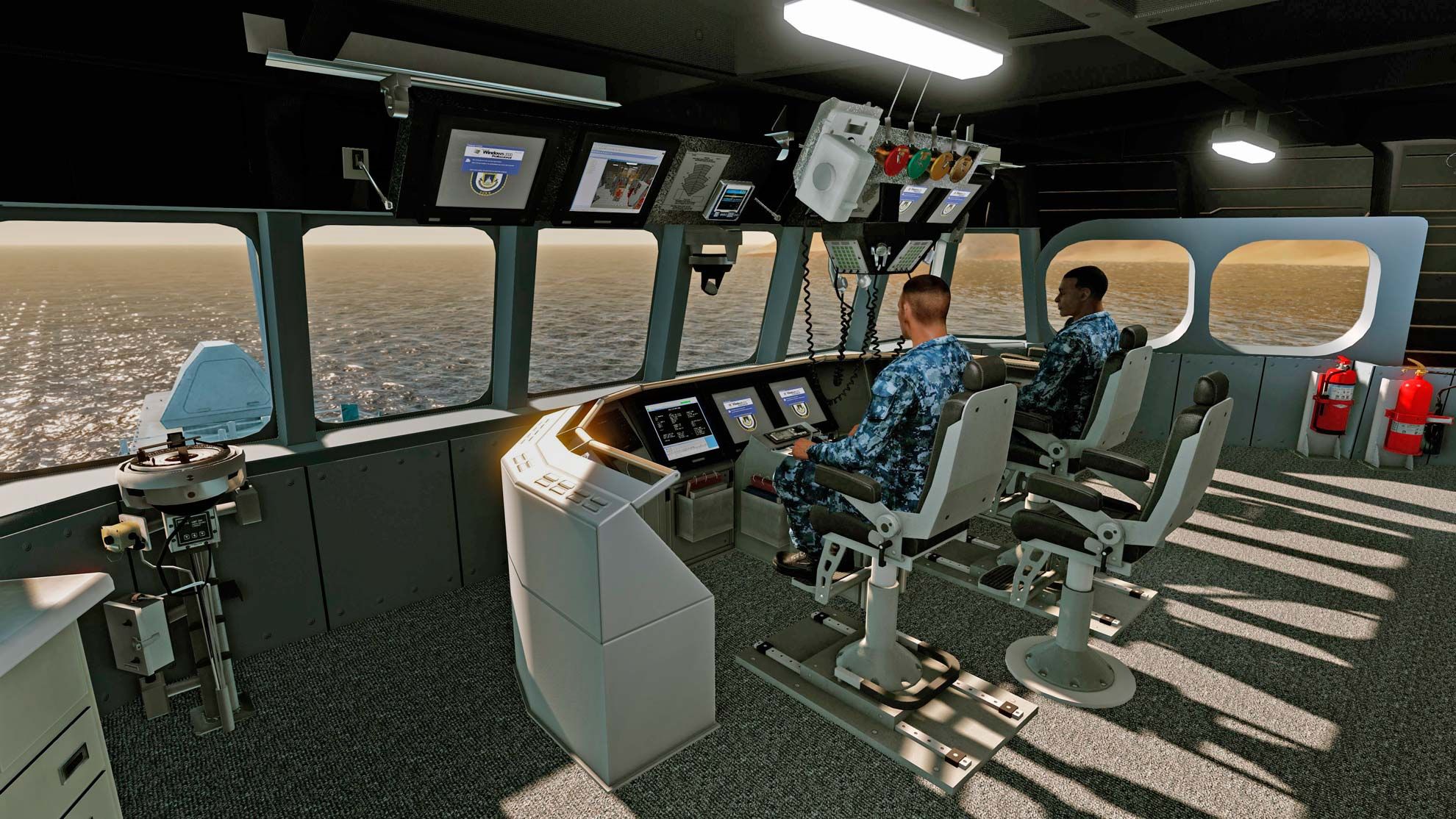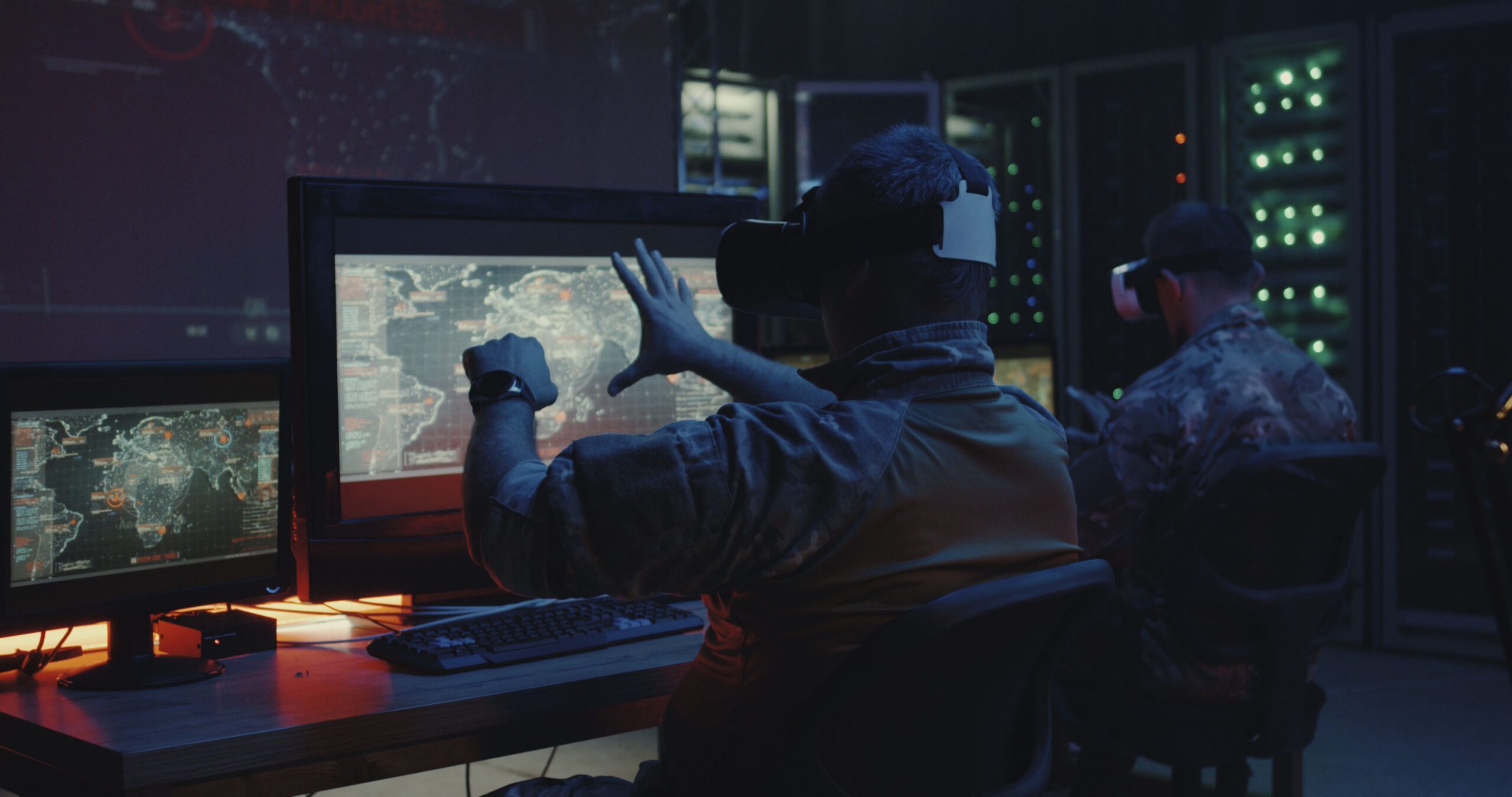
The Navy is the leading practitioner of live, virtual, and constructive training in the DoD, and HII has a strong history of developing LVC solutions in support of the Navy. Image courtesy of HII.
Warriors have been training live since there have been standing armies. They’ve been training virtually since the inception of cockpit simulators in the 1930s. And they’ve been training constructively since miniature ships and tanks were first pushed around a table-top map.
Training, it’s clear, is nothing new. What is new, however, is the integration of Live, Virtual, Constructive (LVC) technologies to create a blended environment that provides a broad spectrum of training capabilities that haven’t been available through any of the discrete LVC simulation technologies.
That melding of L, V, and C creates the most realistic, effective, and affordable training environment ever conceived. It can also help the Defense Department execute on its most ambitious strategy to counter near peers, which has also caught the attention of Congress because of the enormity of this challenge from a technological and cost standpoint.
That strategy is Joint All Domain Command and Control (JADC2), which is intended to connect sensors to shooters with data from all warfighting domains: air, land, sea, space, and cyber. Yet, the services’ main JADC2 programs — the Navy’s Project Overmatch, the Army’s Project Convergence, and the Air Force’s Advanced Battle Management System (ABMS) — are funded separately and operate independently with minimal jointness.
How can the US military truly train to fight as one and in a distributed fashion across vast distances and in space when it trains as three? And how can it improve readiness, imbuing warfighters with better skills while keeping cost affordable and reducing wear-and-tear on ships, aircraft and equipment?
Although achieving the JADC2 vision will require technical virtuosity, its implementation will require general understanding and familiarity across different echelons,” states Rand in a 2022 report entitled, What Is JADC2, and How Does It Relate to Training? “LVC capabilities can help support the scale and complexity of the operations that JADC2 is meant to address. Each aspect of LVC — as well as the overall integrated construct — can support JADC2 in different ways.”
Advanced, networked weapons and sensors demand better training
The DoD Modeling and Simulation Glossary defines L, V, and C as the following.
- Live simulation involves actual, live people operating concrete platforms and systems. It’s real sailors, soldiers, and airmen on training ranges, flying aircraft, deploying ships at sea, driving tanks, and using real weapons. Live training, along with virtual and constructive, are considered simulations because no enemy forces participate.
- Virtual simulation involves real people controlling simulated systems so that a ship in Norfolk and another in Mayport can exercise together as if they were deployed jointly at sea. Virtual simulations place humans in-the-loop and in a central role by having them exercise motor control, and decision and communications skills, usually involving realistic 2D or 3D visualization. Aircraft flight simulators are a common example; for crew on a Navy destroyer it might be an Aegis ballistic missile defense system simulator.
- Constructive simulation includes simulated service members controlling simulated systems. Actual people such as a pilot direct inputs into the simulations, but are not involved in determining the outcomes. A constructive simulation employs a computer program known as semi-automated forces (SAF) or computer-generated forces (CGF) to build tactical simulations with multiple entities such as a pilot-avatar in a simulator on an aircraft carrier in San Diego training wingman tactics with another pilot-avatar on a carrier in Norfolk.
By using all three in a blended fashion, the DoD can now hone its tactics, techniques, and procedures for the Great Power competition, and also conduct testing and experimentation on under-development capabilities that were difficult to do live or virtually.
“Our weapons and sensors are much more advanced and networked now, and we’re developing capabilities under JADC2 by networking those sensors and fire systems together,” said John Bell, technical director of the LVC Group within HII Mission Technologies. “Our ability to fully exercise sensor and fire chains takes both effort and systems in the live environment. In an LVC environment, we can better understand the TTPs that we need to use to utilize newer sensors and weapons systems.”
At the same time, there’s an enormous amount of data to be collected during training events, as well as during testing and experimentation. LVC training gives testers access to much more data than can be collected in live and simulated training. Analyzing that data gives trainers a realistic picture of how effectively the training is being conducted.
“Even more importantly,” said Bell, “it provides a good measure of the actual readiness of the force that’s being trained.”

The melding of live, virtual and constructive training creates the most realistic, effective, and affordable training environment ever conceived. Image courtesy of HII.
The Navy steps out on LVC training
Today, the leading proponent and practitioner of LVC is the U.S. Navy. HII has a strong history of developing LVC solutions in support of the Navy, receiving both the Naval Air Warfare Center Aircraft Division Commander’s Award for Team Performance and the Naval Air Systems Command Commander’s Award in Simulation and Training.
In partnership with prime contractor HII, the service is bringing the Navy Combined Tactical Training Range and the Southern California Offshore Range into the Navy Continuous Training Environment (NCTE) that includes more than 1,200 secure interconnected nodes throughout the US and partner nations. For NCTE, HII has integrated LVC training systems on about 140 ships with more than 40 C5ISR systems operating over multiple enclaves and levels of classification. In 2022, the Navy conducted 367 major training events over the NCTE, not including daily events at the unit level for smaller-scale training.
HII is also the prime for the Navy Integrated Training Environment (NITE), a complex endeavor that combines operations of live training ranges with the virtual and constructive environments. Under a $896 million task order from the Naval Sea Systems Command (NAVSEA), HII has developed an integrated program that enables a continuous, multi-domain, LVC training platform across multiple physical locations throughout the Navy Training Enterprise.
“The Navy is truly leading the Defense Department in LVC, especially in bringing the live into the virtual, constructive environment,” said Glenn Goodman, president and general manager of the HII’s LVC Group, a 1,500-person organization with another 1,500 subcontractors. “Under the NITE contract, we’re bringing the Navy’s 14 tactical training ranges into the NCTE. That really changed the game for the Navy in terms of bringing the L into the VC.”
The Navy has made great strides in the use of LVC, beginning with its Large-Scale Exercise 2021, which brought together US Fleet Forces Command, US Pacific Fleet, and US Naval Forces Europe to train for simultaneous conflict in both European and Indo-Pacific theaters. Results from LSE 2021 are helping the Navy refine Concepts of Operations to include Distributed Maritime Operations, Expeditionary Advanced Base Operations, and Littoral Operations in a Contested Environment.
LVC also took center stage in the last two Advanced Naval Technology Exercises (ANTX). In 2021, four live aircraft connected to the NCTE for the first time, allowing those aircraft to receive constructive radar warning receiver threats generated from the NCTE. Participating with the live aircraft were the Naval Air Warfare Center Aircraft Division’s Manned Flight Simulator emulating a virtual F/A-18E/F, and the USS Bainbridge (DDG 96), an Arleigh Burke-class guided missile destroyer.
“During the event, the live and virtual aircraft performed simulated air-to-surface and air-to-air weapons employments while receiving synthetic radar warning indications and real-time kill notifications from successful weapons engagements,” stated the Navy.
In the 2022 ANTX, the Navy linked inject-to-live, fleet simulators at Strike Fighter Wing, US Atlantic Fleet, Naval Air Station Oceana in Virginia Beach, VA, with Airborne Command & Control and Logistics Wing at Point Magu, CA; constructive threats from the Naval Aviation Distributed Training Center; along with two live aircraft.
The true promise of LVC
While the Navy has led the way among the services in adopting full-spectrum, integrated LVC, in part, because they’re a forward deployed force that operates in a distributed fashion, the Air Force and Army are also investing in LVC.
For example, the Air Force in mid-2022 awarded HII a $79 million Mobility Air Force Distributed Mission Operations (MAF DMO) task order under the Training Systems Acquisition III contract. HII will operate and maintain the Distributed Training Center and Network to support global Aircrew Training Systems.
For its part, the Army is pushing forward with the Integrated Visual Augmentation Systems for VR/AR training, and has plans to buy as many as 120,000 HoloLens combat goggles from Microsoft for more than $1 billion.
In addition, all the services are buying fifth-generation capabilities and investing in sixth-generation ones such as the F-35, the DDG-125 Flight III Arleigh Burke-class guided missile destroyer, and the Future Long-Range Assault Aircraft to replace the Army Black Hawk. For the most part, LVC simulation is the only way to train for the advanced weapon system capabilities those platforms have.
“The true promise for LVC and what it potentially holds for DoD readiness in the face of near-peer competition will come once it’s adopted more widely across the services for truly joint training operations,” said Goodman. “Live- and virtual-only training is time tested but insufficient for what near-peer competitors might throw at US and allied forces in the future.”





















